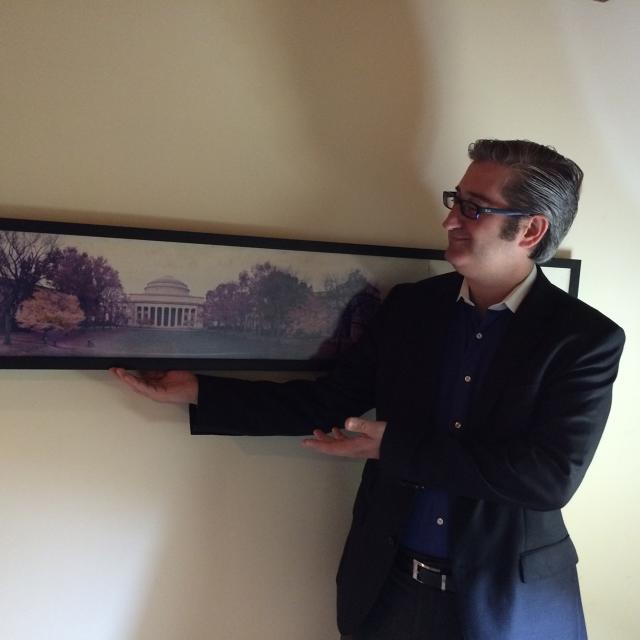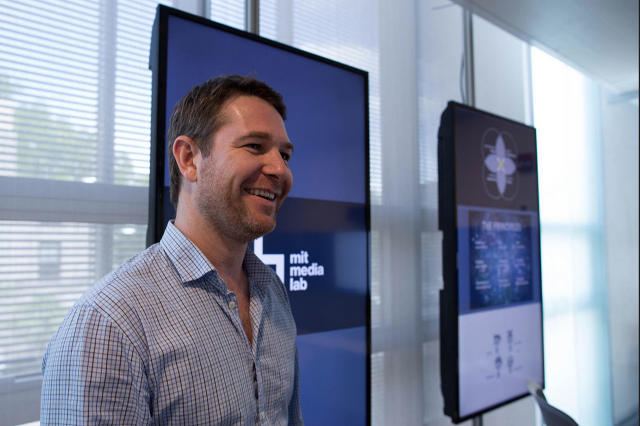MIT’s Plan To Inspire The Next Generation Of Bitcoin Innovators
New courses will study the origins of Bitcoin, and its surprisingly varied potential applications.
In recent years, there has been a lot of enthusiasm for how cryptocurrencies will create new platforms, markets, and economies. But what will the future of commerce and, indeed, the world look like? A vital question, and one that really hasn’t been answered.
Right now, the playing field is a virtual Wild West. The developers behind Bitcoin and Ethereum believe their respective creations can be the platform for everything, and their most vocal chorus of fanboys are crypto-enthusiasts and venture capitalists. But MIT’s Media Lab and the Digital Currency Initiative, in partnership with various other departments, is hoping to change the dialogue, bringing a more balanced approach to imagining the future of commerce.
The Media Lab is now offering two courses. The Future of Commerce (MAS.S63) will explore how blockchains like Bitcoin and Ethereum disrupt existing markets and financial services, and allow graduate students to build new business models, products, or technical concepts. More specifically, students will be taught to imagine the future of money, markets, transactions, and marketplaces, and issues like commerce, security, and privacy.
The other course, Blockchain Technologies (MAS.S65), is a deep technical dive into the blockchain technology behind Bitcoin and other digital currencies. The focus will be on how to scale projects on the blockchain while keeping them secure and private. Students will also learn how to design applications on the blockchain; a great idea since this type of technology can sound rather esoteric—though perhaps not to MIT students.
David Shrier, the Managing director of MIT Connection Science and one of the creators of the program, tells Fast Company the two courses are complementary. “[Future of Commerce] will help build a company or product/service and [Blockchain Technologies] provides strong technical capabilities around the blockchain,” he says. “Your CTO might take both. Your CEO (unless technical) would probably take the Future of Commerce.”

Origin Story
Shrier says that a number of different strands converged in the formation of the courses. For years, the Media Lab had researched not just blockchains and digital currencies, but the future of commerce: predicting markets, harnessing crowds, tuning networks of financial traders to financial policies, and how people could reliably and securely take a currency out of a central ledger (i.e., a central bank). With the Bitcoin blockchain, the last point was suddenly a reality—a decentralized currency that simply exists “out there in the cloud,” as Shrier put it.
The creation of the Digital Currency Initiative within the Media Lab, in collaboration with Computer Science and Artificial Intelligence Laboratory (CSAIL) and MIT Sloan School of Management, also played a part. Add to this a considerable amount of student interest and the emergence and maturation of peer-to-peer networks, and a course on the blockchain became a no-brainer for the Media Lab.
“We want to try and bring all of these things together under one roof, and help inspire a new generation of entrepreneurs,” says Shrier. “We hope to attract MBAs, engineers, designers, and community leader-oriented individuals who are all interested in innovating commerce. The idea is to build multi-disciplinary teams that will work in different problems and hopefully come up with some solutions.”
So, what will set the future digital currency CEO apart from more traditional CEO of the 20th and early 21st century? Brian Forde, director of MIT’s Digital Currency Initiative, wagers that the “Bitcoin CEO” will be similar to a CEO of a company that already uses emerging technologies like artificial intelligence, autonomous vehicles, the sharing economy, and so on. Forde, the former White House advisor for Mobile & Data Innovation, says the reason for this is that there is no specific plan that can serve as a model for future blockchain-based companies.
“You’re breaking existing business models because you have access to new, colorful technologies that haven’t previously been created,” Forde says. “You can’t just read a Harvard Business Review case study to look at past examples because you’re going to be breaking new ground. So, you’ll have to be thoughtful about the implications of what you’re doing and what you can’t see around the corner.”
Infinite Space
Forde draws a parallel between the blockchain and the creation of a “relatively infinite amount of storage” online for very low cost. At one point, no one could have imagined it. Now we have platforms like YouTube, Dropbox, and others.
Similarly, Forde says that no one could have imagined the transaction infrastructure of a bank or credit card company, and now we have that in the form of the blockchain. This gives startup entrepreneurs access to an infrastructure that can scale to a similar size without the cost of building bank infrastructure to process transactions. What happens when the the cost of that infrastructure goes to near zero, and new business models emerge out of this? That’s the question Forde and Shrier hope to answer in the Future of Commerce course by sparking student imagination.
Not surprisingly, that imagination will have to be tuned to various frequencies. Indeed, the future Bitcoin CEO will have to understand cryptography, data, privacy, computer science, economics, monetary policy, design, and various other topics.

“The toolkit is going to have be pretty big,” Forde says. “No one’s a jack-of-all-trades, but you have to have at least a basic understanding of those different areas, which is what makes it so exciting.
“It’s going to require us collaborating with MIT’s Sloan Business School and the schools of Artificial Intelligence and Computer Science,” Forde adds. “And that’s why we have 15 professors working on this because they all come from different disciplines, and it’s going to require all of their insights to be able to build a Bitcoin-based company in the future.”
Though there is a particular emphasis on commerce when Shrier and Forde talk coursework, don’t mistake the new MIT program for an academic pipeline for-profit ventures. There is a big social dimension at the heart of MIT, and this bleeds into the Digital Currency Initiative and the two new courses. Shrier thinks a better way of describing the program’s goal is as inspiring the next generation of “innovators.” This person could be a community or entrepreneurial innovator.
Shrier points to Development Ventures, a course led by instructors Joost Bonsen and Sandy Pentland (one of four Future of Commerce teachers) to emphasize MIT’s commitment to positive social change. In this action lab, students build a venture with one design constraint: It must solve a problem that impacts at least one billion people in the least wealthy countries around the globe.
“Similarly, with future commerce, we’re not restricted to for-profit business models,” Shrier says. “There have been some interesting innovations around using these democratized currencies to build stronger senses of community.”
“One of the students in Development Ventures created a mobile phone-based company, Assured Labor, that helps people find jobs,” Shrier adds. “They partnered with a big telecom and piloted it in Nicaragua and it did really well, and then it got deployed in Mexico and now is one of the biggest platforms in Latin America. That’s another example of future commerce—making it easier for people to transact and connect with each other to get jobs.”
Shrier imagines a world where communities develop their own currencies, based on the blockchain, for a local co-op. This arrangement would essentially create a new version of the barter economy that, he says, “can serve to both build a sense of collaboration and (in theory) hedge against an inflationary currency issued by a central bank—as long as the community holds a constant internal exchange rate”.
Enhanced Prosperity
These commerce innovations wouldn’t be designed or intended to make money themselves. Instead, Shrier said they would serve as a foundation for improving the flow of goods in and out of a community, “enhancing prosperity” in the process. Shrier also sees examples of future commerce in social entrepreneur Duncan Goldie-Scot’s Mobile Microfinance Ltd., a U.K.-based nonprofit that seeks to facilitate microfinance as an engine of economic growth in Africa; and Donors Choose, a website that connects international donors with classrooms with very specific educational needs.
“Now, technology lets us take a digital currency and give it to a poor community in Ecuador so they can have their own community-building currency that can bring people closer together,” Shrier adds. “You can do a lot in Africa and Asia, and we find it exciting that we can drive global change.”
Forde also believes blockchain technology could be used to distribute social welfare in developing nations, evolving it from a cash process into a digital process. More than 2 billion adults around the world do not have access to a bank account, Forde notes, making it difficult to both receive social welfare and drive economic growth through traditional savings and borrowing mechanisms. A future blockchain innovator could help solve this problem.
Forde also says the blockchain could help with issues arising out identity. For example, Forde notes that approximately 33% of children under the age of 5 do not have a government-issued ID. According to UNESCO research, he says, “exclusion from social services, due to lack of formal citizenship status and ID, is the single greatest risk factor contributing to the trafficking of girls in places like Thailand.”
So maybe, just maybe, a future blockchain innovator could tackle human trafficking. And that’s the type of lateral thinking that Shrier and Forde want to bring to the Media Lab’s new blockchain courses.
“MIT’s mission is to solve the world’s biggest problems,” Shrier says. “It’s a very ambitious mission, but we’ve got a great staff here that’s done some world-changing things, and we want to continue that tradition and help bring practical, high-impact solutions to global problems. We see commerce as integral to that solution.”
Fast Company , Read Full Story
(91)



